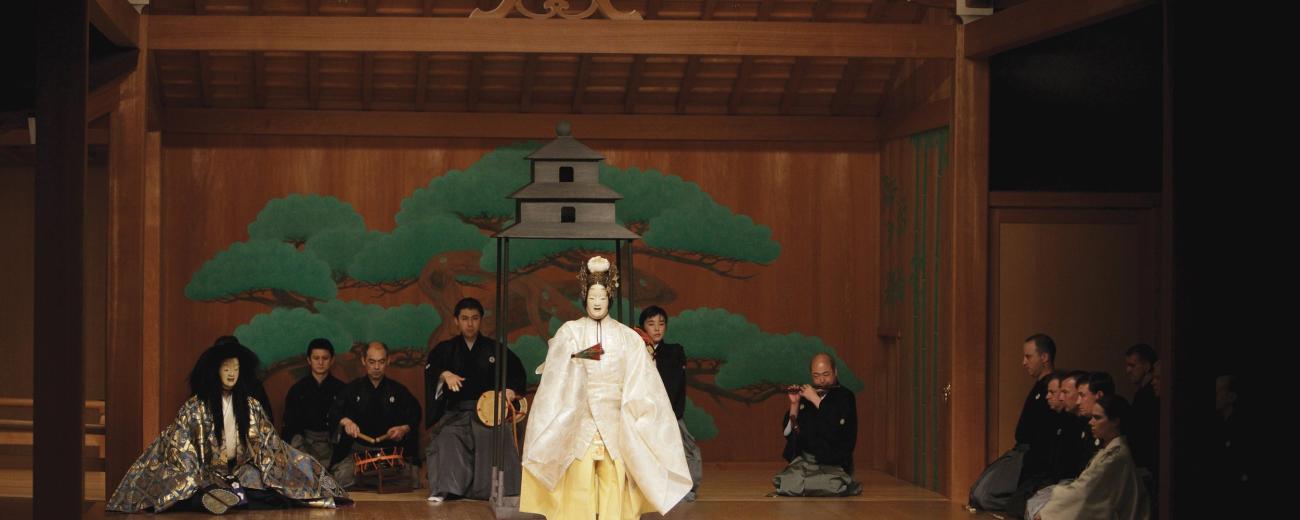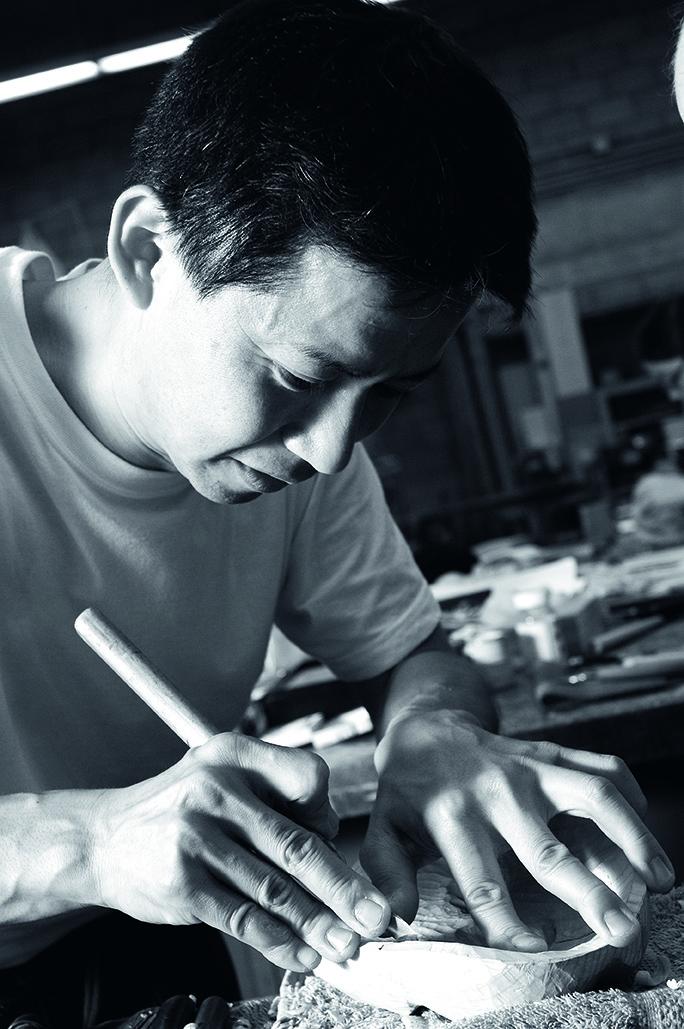
Noh performances of 'Rockaby' and 'Face of a Goddess'

Key information
- Date
- Time
-
6:00 pm to 7:30 pm
- Venue
- Brunei Gallery
- Room
- Brunei Gallery Lecture Theatre (BGLT)
About this event
The programme features two innovative performances that demonstrate the contemporary relevance of Japanese noh drama, one of the oldest continuing performance forms in the world.
The first is Rockaby, a fifteen-minute solo play written by Samuel Beckett in 1980. The play focuses on a Woman, seated in a rocking chair, who is rocked gently into that dark eternal night by her own Voice. In this rarely performed version, directed and performed by the master noh actor of the Kita School, Akira Matsui, and authorised by Samuel Beckett himself, the ethereal beauty of noh offers a stylized and profoundly moving interpretation of Beckett’s play - ‘a moving monodrama fusing poetry, ritual, and drama’.
The second is a brand-new piece, an adaptation of the traditional noh Kazuraki. The story focuses on a mountain deity Kazuraki who attains salvation after a group of sheltering mountain priests pray for her. Featuring the mask maker Hideta Kitazawa, the noh master Akira Matsui, composer and musician Richard Emmert, as well as instrumentalists Laura Sampson (flute) and Ashley Thorpe (taiko drum), this innovative performance is a mediation on the noh mask, spirits, and the significance of ritual.
Rockaby
Rockaby is one of Samuel Beckett’s final works. It is even more minimalist than most of his other theatre pieces, relying on heavy repetition of words and structures to make its point. Like most of Beckett’s works, Rockaby’s action proceeds with a strong - but not always immediately apparent - tone of finality. It is impossible to say whether the end of the Woman’s life is even the main event. The repetitions are tainted, desperate portents of the Woman’s grief at living in unending isolation and loneliness. In this version, the speaker of the words is on stage as the Woman’s carer, reading the book the Woman had been reading. The words could be the voice of a mother, a daughter - a woman who could be real or imaginary. Here, the Woman becomes identifiable as a daughter, repeating the actions of her mother. The repetition is the rocking chair. We could face the same end as the Woman. Given the nature of today’s ageing society, and the questions surrounding care for the frail and elderly in our communities and medical institutions, we too must face the necessity of preparing for life’s end.
- Woman: Matsui Akira
- Voice/Carer: Laura Sampson
Face of a Goddess (based on the classical noh Kazuraki)
This work is based on the story presented in the classic noh Kazuraki, in which a group of yamabushi mountain priests on pilgrimage near Mt Kazuraki meet a strange woman, who offers them shelter from a snowstorm. The woman is revealed to be a tortured deity of the mountain, bound with vines long ago by En no Gyouja (the first and most powerful yamabushi) in punishment for failing to build a stone bridge from one peak to another. Her guests agree to pray for her release, and the woman disappears - later reappearing in the form of a beautiful goddess who dances an ancient heavenly dance in gratitude. In this performance, a noh mask maker is giving a demonstration to an audience of craft enthusiasts, when an unknown voice interrupts. The voice - which belongs to a ‘deity of unsightly face’, is pleading for help that only the mask maker can give: a new face whose beauty matches that of Amaterasu, sun queen and first ruler on Mt Kazuraki, home of the first gods’ mythical offspring. Captivated by one of his masks, the deity tells his story, and the artisan offers the mask up as a gift. Then in the same gratitude and delight as in the noh, the deity dances, now wearing the beautiful shape of a goddess with a face to (finally) be proud of.
- Mask maker: Kitazawa Hideta
- Deity: Matsui Akira
- Voice/Taiko stick drum: Ashley Thorpe
- Kotsuzumi shoulder drum/Chant: Richard Emmert
- Nohkan flute: Laura Sampson
About the performers
Matsui Akira is an actor-teacher of the Kita School of classical noh based in Wakayama, Japan. He began studying noh at the age of 7 and took on numerous child roles. At age 12, he became a ‘live-in apprentice’ to Kita Minoru the 15th head of the Kita School. He has for over 50 years been active teaching, performing and collaborating with international performers in over 25 countries. In 1998, he was designated an Important Intangible Cultural Asset by the Japanese government and has been awarded four major cultural prizes from the Wakayama Prefectural and City governments. In 2016 he was awarded an Honorary Doctorate from Royal Holloway, University of London.
Kitazawa Hideta is a wood sculptor and noh mask maker based in Tokyo. He learned traditional wood carving of Buddhist and Shinto statuary from his father, Kitazawa Ikkyo, and later studied noh mask carving. He currently produces classical noh and kyogen masks and has been designated a master craftsman by the Tokyo Metropolitan government. Kitazawa has also created numerous shinsaku “new” masks for foreign language noh productions, notably those of Theatre Nohgaku, as well as for other noh-influenced plays. He has given workshops and demonstrations in Japan and internationally and a book on his work entitled Noh and Kyogen Masks will be published by Prestel in Autumn 2024.
Richard Emmert is professor emeritus at Musashino University, Tokyo, where he taught classical noh and Japanese and Asian traditional performing arts. Born in Ohio (USA), he is a certified Kita school noh instructor and has led noh performance workshops worldwide. Founder of Theatre Nohgaku, he has composed noh music for numerous English noh productions for which he was awarded the Koizumi Prize for 2019. He recently composed music for a French noh and arranged music for a Spanish noh. He co-authored a series of seven noh performance guides and authored the six-volume The Guide to Noh of the National Noh Theatre, both for Tokyo’s National Noh Theatre.
Ashley Thorpe is Reader in the Department of Drama, Theatre & Dance at Royal Holloway University of London. He began studying noh in 1997 and has been taught by Kita School performers, Richard Emmert, Akira Matsui and Teruhisa Oshima. Theatre Nohgaku member and Director of the Noh Training Project UK which began in 2011, he has published twelve books, including the forthcoming Intercultural Japanese Noh Theatre: Texts & Analyses of English-Language Noh. He has also written his own English-language noh, Emily which premiered at Tara Arts, London in 2019, and has performed in international touring productions of the English-language noh Between the Stones (2019) and the French-language noh Medée (2023 & 2024).
Laura Sampson is a London-based storyteller and writer. Recent projects include storytelling with National Trust, Young V&A and leading UK storytelling organisations Crick Crack Club and Story Jam. Her first book, Enchanted Tales (Templar) was published in October 2023. Laura has practised noh since 2011 and is a performer-member of Theatre Nohgaku. Current English-language noh (and noh-inspired) projects include Blue Moon Over Memphis (Tokyo) and Medée (Paris), solo storytelling shows Yamanba (2024) and Legend of the Burning Bell (2019), alongside musical collaborations with contemporary composer Anna Murray (Ireland). She is also an MA Japanese Studies student (SOAS).
Registration
This event free and open to the public. These performances will be in-person only. If you would like to attend, please register using the link above.
This event is part of the 'From Tradition to Modernity: Understanding nohgaku from its establishment 650 years ago to contemporary times' series of events. The full programme of events can be found on the Between the Stones website.
Header image credit: Oshima Kinue performs Pagoda at the National Noh Theatre, Tokyo, December 2009. Photo: Kitazawa Sohta







